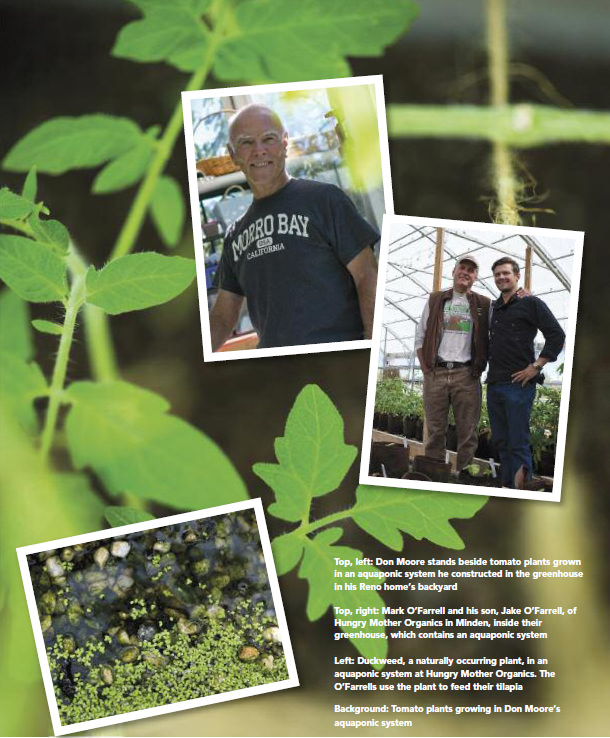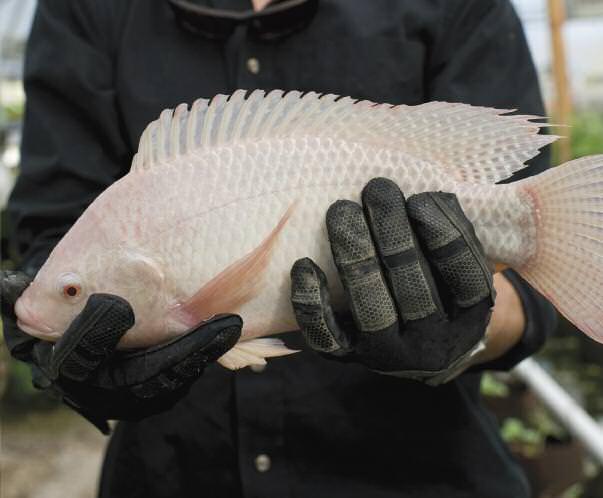feature
FULL CIRCLE
Aquaponics joins the wave of sustainable gardening practices.
WRITTEN BY SUE EDMONDSON
PHOTOS BY CANDICE NYANDO
If you love to garden but aren’t crazy about earth-stained fingers, if organic produce is your kind of food, and if you think fish are fun to raise and good to eat, aquaponics may be for you.
Simply put, aquaponics is a growing system where nutrient-rich water from fish tanks is cycled to plants grown in a soil-free medium, then returned, naturally filtered by the plants, to the fish. With a bit of tinkering to maintain the proper chemical balance, both plants and fish flourish.
Like many agricultural practices, it’s as old as dirt. Thousands of years ago, the Chinese irrigated rice paddies with water from catfish ponds.
“The concept of aquaponics isn’t new,” says Heidi Kratsch, University of Nevada Cooperative Extension horticulture specialist. “It’s just being repackaged in the context of urban farming.”
No water worries
When Mark O’Farrell and son Jake considered aquaponics for their Hungry Mother Organics farm in Minden, they hoped to accomplish three things: to introduce fish into an integrated agricultural system, to reduce labor and plant-growing costs, and, most importantly, to save precious water.
The O’Farrells’ greenhouse-based system is a success, commercially and personally. In less than a year, they’ve sold hundreds of pounds of tilapia, tomatoes, and salad greens using the sustainable system that fits their philosophy of eco-conscious farming.
“We estimate a 90 percent reduction in water usage,” Jake says. “That’s a huge benefit, especially in our desert environment.”
How it works
In their greenhouse, a liner covers the dirt floor, and inert (chemically neutral), porous gravel covers the liner. When water is gravity-fed to the gravel-filled grow troughs, the excess drips onto the floor and is pumped back to the fish tank. From the fish tank, it flows through red worm beds before heading to the plants.
“Worms are bio-digesters of the solid fish waste,” Mark says. “From a food-safety standpoint, worms seek out the harmful pathogens and reduce the risk of E. coli and salmonella. They speed the process to make nutrients available to plants.”
The system allows year-round growing. When needed, an efficient, condensing hot-water heater warms the plant beds. The recycled warm water then heats the fish tank. As a result, the greenhouse never requires separate heating. Throughout the summer, the constant flow of water helps keep the greenhouse cool.
“We ate tomatoes all winter and greens all summer,” Jake says. “We can supply locally grown produce year round.”

On a small scale
Don Moore and Cathey Ree’s shady patio is perfect for summer entertaining, but not so great for growing vegetables. After reading Sylvia Bernstein’s Aquaponic Gardening, Moore decided a greenhouse aquaponic system might solve the problem. A dedicated DIY guy, he wasn’t about to order pre-fab if he could build it himself.
“I bought three food-grade IBC totes for the system from Twin City Surplus (in Reno) and built the rest of it from scratch,” Moore says. “Plumbing skills help, but they aren’t critical. You can find instructions online or in books.”
The totes support a 275-gallon fish tank, pump, and three 12-square-foot grow beds. Ree (the family gardener) has grown basil, peas, beans, and lettuces.
“The biggest challenge was getting the pH right,” Moore says. “Once I figured that out, it’s worked perfectly.”
About pests
“The best practice is integrated pest management,” Kratsch says. “Monitor, use sticky traps for white flies, and, if necessary, introduce beneficial insects.”
University of Nevada, Reno student Trudy Myers grows marigolds to help with pest control in her koi-based aquaponics system at the Valley Road Field Labs. So far, they’ve worked. She encourages gardeners to try aquaponics.
“Everything I’ve planted grows,” Myers says. “If I can do it, anyone can.”
Freelance writer Sue Edmondson writes for publications in Northern Nevada and California. She is considering an aquaponic system for her greenhouse.
Local resources and workshops
UNCE is offering an aquaponics workshop in April. For details, visit http://www.Growyourownnevada.com
Reno Hydroponics
http://www.Renohydro.com, 775-284-8700
Anything Grows Hydroponics
http://www.Anythinggrowshydro.com and 775-828-1460
Twin City Surplus
1675 E. Fourth St., Reno, 888-323-5630 (IBC totes for water tanks)
Trudy Myers may be contacted by email
http://www.Omaye@cabnr.unr.edu
http://www.Theaquaponicsource.com
The Alternative Farming Systems Information Center: http://www.afsic.nal.usda.gov (search aquaculture)
http://www.Backyardaquaponics.com
YouTube how-to videos (search “aquaponics;” a good place to start is with Purdue University’s video)
Books
Aquaponic Gardening by Sylvia Bernstein
The Complete Idiot’s Guide to Aquaponic Gardening by Meg Stout


